Difference Between Laminate, Veneer and Solid Wood Furniture
Is solid wood better than veneer? Is veneer better than laminate? What exactly are the differences? Choosing new furniture for your home comes with lots of decisions, often starting with the type of material used in the pieces. Furniture made from laminate, veneer and solid wood all come with pros and cons. Understanding the differences among them helps you decide which furniture material is best for your home.
Basics of Laminate
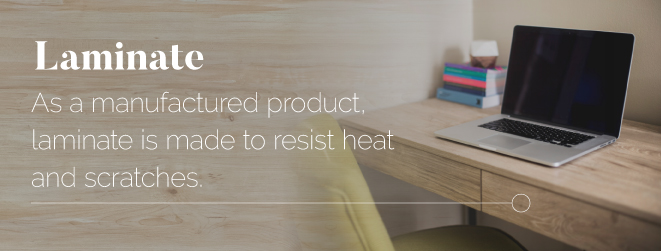
Laminate furniture consists of synthetic materials used to form a thin layer that looks like wood. Since it’s not actually made from wood, laminate pieces often look manufactured. The laminate gets its wood grain appearance through a printed process. Those printed sheets are then attached to a durable core material, such as MDF — medium-density fiber. Laminate pieces often have a shiny finish.
As a manufactured product, laminate is made to resist heat and scratches. That strength means you don’t have to be quite as careful with laminate as you do with solid wood or veneer. For this reason, some people choose laminate over other types of furniture for busy areas of a house or areas where the furniture might get a lot of heavy use.
Pros of Laminate
While it might seem that a product not made of wood lacks benefits, it does have some good qualities, depending on your needs. Here are a few of the potential positives of choosing laminate furniture:
- Cost. Laminate is generally the least expensive of the three main furniture types. If cost is your only qualifier, this can be a plus. You get what you pay for, so it’s not necessarily an investment piece. You may spend more down the road to replace laminate furniture that doesn’t hold up well.
- Easy cleaning. Furniture made from laminate is easy to clean. Since the material is durable, you can wipe it down easily without worry of damage. Because it’s not actual wood, you don’t have to worry about specialized cleaning products.
- Durability. Laminate is a relatively durable material, making it perfect around kids or pets.
- Low Maintenance. This type of furniture doesn’t need much maintenance. You won’t need to polish or refinish the piece on a regular basis to keep it up. It can last several years without fading.
- Greater Color Options. Since manufacturers make the laminate from synthetic materials, the options for colors and appearance vary much more than solid wood. That variety lets you get a unique look for your furniture pieces. For example, exotic wood species are very rare to find in solid wood, but it’s a bit easier to make a laminate furniture piece look like that exotic species.
Cons of Laminate
The cons of buying laminate furniture are worth considering before you make a purchase. Here are some potential negatives of laminate furniture:
- Lower Quality. Because it is made of synthetic materials rather than real wood, laminate is lower quality than either veneer or solid wood, which is also why it costs less. When you’re looking for a solid, heirloom piece, laminate is not the best option.
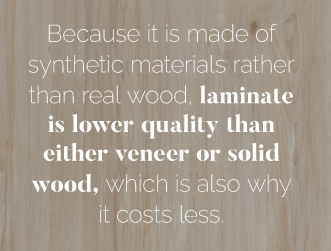
- Limited Refinishing Options. Since laminate contains no real wood, you can’t stain it. You can paint it if you use proper preparation techniques, but the lack of staining limits your options for changing the look of the piece or repairing it if the laminate furniture starts to show signs of wear.
- Lack of Natural Variations. Color and appearance options are expansive with laminate, but you miss out on the natural variation you get with real wood. Since the wood grain image is printed onto the laminate, you don’t get a true wood look. Those knots, wood grain variations and other distinct markings of real wood are lost.
- Manufactured Appearance. A low-quality laminate piece lacks a realistic look. You can often tell the piece is laminate due to the manufactured appearance of the wood grain. Higher-end laminate pieces have a slightly more realistic look, but it’s not the same as a piece made from real wood.
- Shorter Life. Even well-made laminate furniture doesn’t have the longevity of solid wood pieces. If you’re looking for a lasting piece, laminate is probably not the best option. Instead, invest in a solid wood piece that withstands generations of use.
Veneer Basics
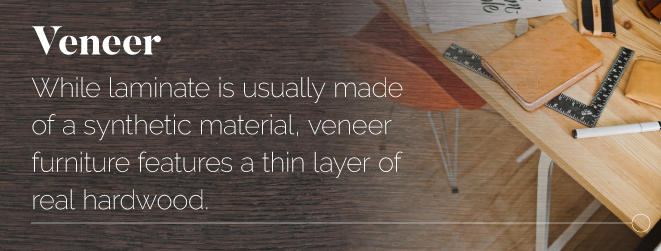
The construction method for veneer furniture is similar to laminate furniture, with the primary difference being the actual material used as the outer layer. While laminate is usually made of a synthetic material, veneer furniture features a thin layer of real hardwood. That hardwood layer covers the lower quality wood base, such as cheaper wood, MDF or particleboard, creating the look of solid wood furniture with a lighter core. The veneer layer is usually less than 1/8 inch thick.
When compared to laminate, veneer is a softer material, which makes it scratch and dent more easily. That softness requires a little more care to keep the veneer looking good. Veneer is not a new material. Even older pieces are sometimes made with a veneer construction method, so age alone is not a determining factor in whether a piece is veneer or solid wood.
Pros of Veneer
It’s not solid wood, but veneer is a solid choice for some people, depending on their furniture needs and budget. Check out these benefits of choosing veneer furniture.
- Moderate Price Point. Veneer furniture typically costs more than laminate furniture but less than solid wood furniture. It offers a budgetary compromise if you aren’t comfortable with solid wood furniture prices but want to spend a little more than laminate.
- Authentic Look. Veneer furniture uses a thin layer of real wood, unlike laminate, which is just made to look like wood. This gives the furniture piece a higher-quality appearance than laminate, which can make the piece seem high end when compared to laminate.
- Uniformity. Since veneer is a manufactured product instead of harvested and crafted from solid wood, the pieces often have a more uniform appearance. This sometimes makes it easier to match the pieces with other veneer furniture.
- Warp-Resistant. Furniture made with wood veneer resists warping. That means it retains its look long term. Solid wood furniture is more susceptible to warping than veneer furniture.
- Lightweight Construction. The core of veneer furniture is made of a variety of materials, such as MDF and particleboard. These materials are lighter than solid wood and rely on glue and chemicals for strength. While this construction makes them a lower quality, it does make the furniture lighter for moving or rearranging.
- Refinishing Options. The outer layer of veneer furniture is made from real wood, so you can refinish it like a solid wood piece. You have the option to paint or stain veneer pieces. Like any furniture piece, you need to prep the veneer to help the paint stick properly. Because the wood layer is so thin, you don’t want to sand it too much. Hand sanding is usually best, as a power sander can go right through the wood layer to expose the cheaper material below.
- Greater variety: Because the thin layers require so much less real wood, you may have an easier time finding exotic wood pieces in veneer.
Cons of Veneer
While veneer is a good compromise material, some negatives may sway your decision to invest in veneer pieces. It’s important to have a full picture of the material’s characteristics to ensure the pros outweigh the cons if you’re considering veneer. Consider these potential problems with veneer furniture:
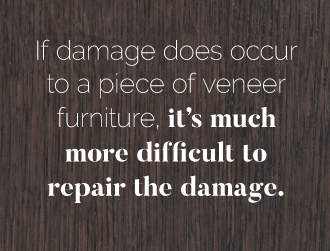
- Scratches Easily. Veneer is durable overall, but it is more susceptible to scratching than other furniture materials. This means you need to be a little more careful with veneer furniture than you would with laminate or solid wood. You may want to skip veneer in high-traffic areas or in kids’ rooms, where they are likely to get scratched or dented.
- Repair Difficulty. If damage does occur to a piece of veneer furniture, it’s much more difficult to repair the damage. You may be able to sand out some light scratches and refinish the piece, but if the veneer starts to peel or a large chunk is missing, it’s almost impossible to restore the piece to its original state without showing signs of the damage.
- Unknown Materials. You never know what materials your veneer furniture contains. The core often has a mix of chemicals, glues and other components. With solid wood furniture, you don’t have to guess what’s inside the piece.
- Veneer Damage. Veneer holds up well under normal conditions, but, over time, the veneer layer may start peeling or blistering. Once this happens, there’s no effective way to fix the damage.
- Moisture Issues. If a veneer piece has a particleboard core, it’s more likely to absorb moisture than solid wood pieces.
- Damage During Moving. Because of the materials used, moving veneer pieces may cause loosening in the joints, which reduces the overall stability of the piece.
Solid Wood Basics
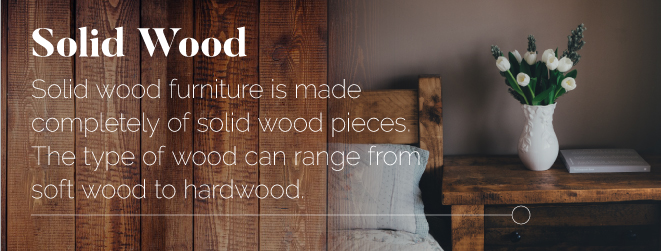
Solid wood furniture is made completely of solid wood pieces. The type of wood can range from soft wood to hardwood varieties, each with distinct characteristics and features. The many varieties of wood let you choose a look that fits your style and coordinates with the décor in your home.
Solid wood furniture shows all the knots, texture and variations from the original wood — and those unique features go into the final product. Each piece is special, with slight variations, even if the furniture follows the same specifications.
Pros of Solid Wood
Solid wood already has a strong reputation as a quality furniture option. Many people consider solid wood the best material when buying new furniture. It’s true that solid wood furniture comes with many pros to consider when picking furniture. Some of the positives include:
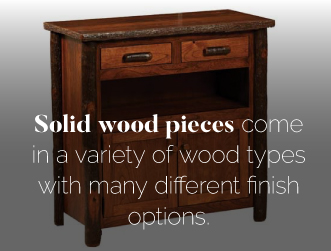
- Classic Aesthetics. Solid wood is a classic furniture option. It works well with any décor and offers natural beauty appealing to people with a wide range of styles.
- Character. Solid wood comes from harvested wood sources rather than being manufactured based on certain specs or to create a uniform look. Solid wood construction means no two pieces are exactly alike, giving each solid wood piece unique character.
- Durability. Furniture made from solid wood is very durable. It holds up to regular day-to-day use, making it ideal for any type of furniture in your home.
- Versatility. Solid wood pieces come in a variety of wood types with many different finish options. No matter what wood material and finish you choose, solid wood pieces offer versatile decorating potential to work with your existing furniture and décor pieces.
- Restoration Potential. A furniture piece made from wood has the potential to be restored should it start to show signs of wear. Scratches, dings and other minor damage can be fixed. You can also paint or stain solid wood furniture easily to change the overall look of the piece. This helps the piece match your evolving style preferences.
- Natural. Solid wood furniture comes from nature. It’s not full of heavily processed materials with lots of chemicals like veneer or laminate. If that natural connection is important to you, opt for solid wood pieces.
- Increased Value. Solid wood pieces often retain their value or even increase in value over the years. Even if you don’t want to keep the furniture forever, you can sell solid wood pieces at a premium. Veneer and laminate pieces tend to decrease in value.
- Strength. Pieces made from solid wood offer a natural strength. This makes them ideal for furniture legs and support elements on furniture. Wood is better suited to accept nails and screws for more durable construction. Pieces made of solid wood handle heavy loads well.
- Longevity. Solid wood furniture is not a temporary furniture option. It’s durable and long-lasting furniture. You can buy a solid wood piece and still have it decades from now. Many people pass solid wood furniture down through generations because of its enduring quality.
Cons of Solid Wood
Solid wood is generally a solid choice for furniture pieces, but there are some potential issues. Your specific needs and wants come into play when determining if certain characteristics are negatives for you. Consider these traits of solid wood furniture that could require a little attention.
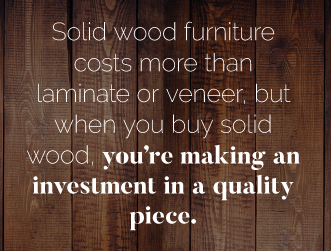
- Soft Wood Vulnerability. If you purchase furniture made from a soft wood variety, the pieces have a greater chance of some damage over time, especially along the edges or at the corners. These pieces work best in low-traffic areas away from kids and pets who can be rough on furniture. Another solution is to choose furniture made from hardwood varieties to minimize the potential for damage.
- Cost. Solid wood furniture costs more than laminate or veneer, but when you buy solid wood, you’re making an investment in a quality piece. Solid wood furniture lasts for generations when you choose quality built pieces and maintain them properly. When you think about the length of time you’ll keep the piece, it may save you money over time since you won’t have to replace the pieces anytime soon.
- Weight. While the hefty construction keeps solid wood furniture stable and strong, it also means the pieces are quite heavy. This isn’t a problem once you position your piece, but if you like to rearrange or if you move frequently, the weight can present a bit of a challenge. Hiring professional movers alleviates the strain of moving your heavy solid wood furniture pieces yourself when you move to a new home.
- Susceptible to Extreme Conditions. Moisture and extreme temperatures often cause warping, cracking, swelling and other changes in solid wood. Wood expands and contracts, which can shift the entire structure of the furniture. As long as you keep your solid wood pieces in a consistent environment without extreme moisture or large shifts in temperature, this shouldn’t be a major issue.
- Quality Variation. Solid wood pieces are generally high-quality, but the actual wood selected and the construction methods used affect the overall quality and durability of an individual piece. Low-quality wood lacks the natural beauty and longevity of higher quality woods. Poor construction leaves solid wood pieces wobbly and susceptible to damage. Buy furniture from reputable craftsmen or manufacturers to ensure you invest in a lasting piece of solid wood furniture.
Tips for Choosing Laminate, Veneer and Solid Wood

So, is wood, veneer or laminate better? As you can see, the answer isn’t always black and white. Your personal needs help you determine which option is best. If you’re not sure which direction you want to go, consider these tips:
- Decide on Maintenance. How much upkeep do you want to do on the furniture? Is a low-maintenance piece more important than looks, or are you willing to do maintenance on solid wood to get the higher quality piece? With regular use, even solid wood requires minimal maintenance.
- Set a Budget. Decide how much you want to spend on your furniture. If you have an open budget, you don’t need to set any restrictions on material type based on budget. If you have a very tight budget, however, laminate or veneer may be a good solution for now.
Shop Laminate, Veneer & Solid Wood Furniture
All three types of furniture come in a range of prices, so don’t discount a particular type of furniture based on budget alone. Also, remember you get what you pay for. If you increase your budget a little, you can get a higher quality piece that lasts.

- Consider Length of Investment. How long do you plan to keep the furniture? Are you buying a temporary piece until you move or are you saving more money to invest in higher quality pieces? If you want to keep the furniture indefinitely, solid wood is your best bet.
- Compare Durability. All three types of furniture offer some durability. When comparing veneer and laminate, a laminate piece offers greater resistance to damage. However, you give up some of the realistic look that comes with veneer. Solid wood offers a great deal of overall strength and stability.
- Consider Location. The traffic in the location of the furniture piece plays a role in the type of furniture you choose. If you’re buying a piece for a high-traffic area, veneer may receive damage more easily than laminate or solid wood.
- Decide on a Look. If you want a realistic wood look, solid wood is the best option. Veneer is also an option since it is made from real hardwood. Skip laminate if a classic wood look is a priority. The printed wood grain just doesn’t have the same richness, depth and variety as the real thing.
If you decide solid wood furniture is right for your home, browse our options at AmishOutletStore.com. We offer quality handcrafted furniture, with each piece custom-made using quality wood and reliable construction techniques. The natural wood grain gives each piece character and richness. You know you’re getting a unique piece since no two pieces are exactly the same. When you’re looking for a quality piece customized to your specifications, turn to AmishOutletStore.com.












 Are you a visual person? Check out our video to see how easy our process is!
Are you a visual person? Check out our video to see how easy our process is!